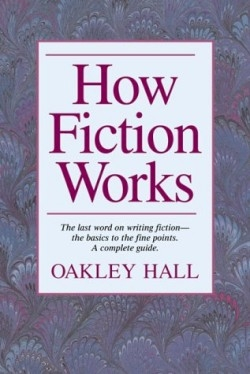How Fiction Work
According to an editor friend of the author, ninety percent of first novels fail because of plot deficiencies. Hall’s book gives first time, and even previously published, novelists a thorough lesson in how to not only identify good writing in others, but how to go from reading it to writing it.
How Fiction Works is constructed like a good analytical problem. The specific parts, such as word choice, point of view, and plot are laid out and discussed in Part I, The Dramatic Method. Part II, Forms of Fiction, then summarizes them into the whole of a short story, novella, or novel, and discusses the proper mixture of each in these mediums. Throughout, Hall uses over one hundred examples of writing from other authors and his own writing. He shows the good as well as the improvable. In discussing modifiers, he shows how Curzio Malaparte misuses them in his novel Kaputt: “I noticed his wide, flat face with its hard, coarse features. His eyes shone with a deep black fire in his pale, earthen-colored face.” By doubling the modifiers, Malaparte has lent an awkward rhythm to his words. In contrast, Hall provides a smoother usage example from Laurie Lee’s “A Wine Cave in Algeciras, 1949”: “We entered to the cry of a fisherman singing an ecstatic fandango that shivered the roots of one’s hair. The singer, who was leaning against a huge sweating barrel of amontillado, was a short wiry little man, scrub-haired, swarthy-faced, with a profile from Egypt.”
In addition to the examples, Hall offers formulas to effectively compose a certain element of the fiction. For instance, when crafting dialogue Hall suggests that there be only one thought per speech and no more than three sentences without an indicator that this speech is important. His examples show the speakers making gestures such as raising their hands or gripping a rail white-knuckled to catch the reader’s attention.
Lists are also scattered throughout the book, beginning with a list of fifteen writing tips in the introduction that includes writing every day and employing all the senses. The appendix consists of various lists from other authors of important fiction to the one hundred best English-language novels of the twentieth century according to the Modern Library editors. An interesting note is added by Hall indicating that this list is sometimes criticized by outsiders for being too close to the list of books published by the Modern Library.
Hall’s considerable background includes nineteen novels (the first published in 1949) and twenty-two years as a professor of fiction writing at the University of California at Irvine. This experience creates a book that would be useful in a college creative writing course or as a centering piece for an adult writers group. Hall’s large vocabulary (verisimilitude, circumlocutory, casus belli), however, might be overwhelming for many younger students of writing.
Whether one wants to author a literary piece driven by character development or a fast-paced mainstream thriller revolving around a thick plot, Hall’s book empowers writers with a clear knowledge of the craft of fiction writing and inspires one to create.
Reviewed by
Christine Canfield
Disclosure: This article is not an endorsement, but a review. The publisher of this book provided free copies of the book to have their book reviewed by a professional reviewer. No fee was paid by the publisher for this review. Foreword Reviews only recommends books that we love. Foreword Magazine, Inc. is disclosing this in accordance with the Federal Trade Commission’s 16 CFR, Part 255.

